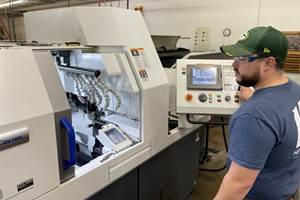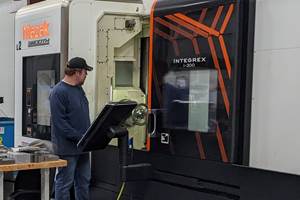Shop Reduces Paperwork With Shop Management Software
With two mechanical engineers, this small shop accepts not only contract jobs, but the shop will 'take anything--from an idea needing design work, to production jobs or reverse engineering from a part.
Share





Cutting Edge Manufacturing Corp. (Phoenix, Arizona), a design fabrication firm, began operating in 1998. With two mechanical engineers, the small shop accepts not only contract jobs, but, according to owner Robert Scalara, the shop will "take anything—from an idea needing design work, to production jobs or reverse engineering from a part." In fact, the shop recently began making and marketing its own product, a utility/pocket knife called the Superknife.
The shop's workhorse is its waterjet machine, on which the shop cuts a large variety of architectural components. "We do a little bit of everything," Mr. Scalara says. "We have a CNC mill, a manual mill and manual lathe, too. We do a lot of welding—we have a couple of TIG welders and a couple of MIG welders, as well as band saws and tube benders."
"There were just two of us running all the jobs here in 1998," Mr. Scalara explains. "Each of us knew what the other was doing. As the business grew and we added to the office staff, I often wondered what might be slipping through the cracks." At times, it was frustrating trying to keep track of the jobs. Notes might be written on paper—and the paper disappeared. "We tried several systems to help organize, but as we grew, we knew there was a better way, and we started looking for software."
Having previously worked for a large manufacturer, Mr. Scalara was familiar with MRP and tracking software. Friends advised him to get the software before the shop grew too large, as it would be better to get it early and let the shop grow with it. "That type of insight helped us make our decision to bite the bullet," he says. "We'll get comfortable with the software at our own pace, even if we don't use all of it. At least it's in place and we can grow into it."
What Mr. Scalara was looking for was a method to track everything in a small shop—to enter jobs and get status reports when those jobs were done, to prepare shippers and track time, and to have the necessary information when it was time to bill the customer. "I knew what shop software could do and was looking for something affordable for a shop our size."
"When we chose Visual EstiTrack from Henning Software, it was because it seemed to offer the most for the money," Mr. Scalara says. Though he knew he'd begin by using only a few of the system's capabilities, he ultimately planned to use all of the software's capabilities, so he wanted a comprehensive system. Hence, his purchase also included the integrated accounting package, Visual Books.
One aspect of EstiTrack that Mr. Scalara appreciates is the flexibility it provides for entering jobs at any point in the cycle. "We run some jobs completely through [the software], from order entry to printing the shipper. For others, we do just the shipper or a sales order and a shipper. Some jobs are turned around really fast; [for example], a customer from across town might bring in a broken part to be welded back together." That is a 10-minute effort, but it might take more time at the keyboard than it did in the shop. "So, I may just do a shipper and in it appears automatically in the Batch Invoice Generator," says Mr. Scalara. "The important issue is that the invoices get generated as quickly as possible with the least amount of paperwork."
Mr. Scalara's software search had focused on helping manage the shop's jobs. He hadn't considered new accounting software. He learned that most shop management software, including EstiTrack, would interface with the company's QuickBooks software, "but not on the level that I wanted." Mr. Scalara wanted to avoid adding a separate step to export and import shop data into his accounting software. "I didn't want to have to reenter any orders or invoices. The price for the Henning's integrated Visual Books accounting package was attractive, and it did what we needed, so we went ahead and acquired it along with Visual EstiTrack.
"There is a lot to learn in Visual Books, though it wasn't difficult—the software does a lot. I think the hardest part for us, when we realized all of its capabilities, was deciding how much do we really need to do at this time? At some point, if it is a $100 job, you have to decide how much detail you want with that job, versus what details we need for the $100,000 job."
Mr. Scalara is confident that he's found a happy medium that yields the results Cutting Edge needs now, but one with which the shop can grow. "We run all quotes through EstiTrack," he says. "I can just ‘walk down the line'—we've entered every machine in the software, along with our shop rates, and it works well."
While he likes the flexibility of EstiTrack now, Mr. Scalara plans to continually implement more of its features.
Related Content
Data Visibility Boosts Beryllium Shop’s Revenue
Consistency is key for beryllium manufacturing, so the data visibility granted by Harmoni has swiftly become a vital, profitable tool in the shop’s arsenal.
Read MoreERP Provides Smooth Pathway to Data Security
With the CMMC data security standards looming, machine shops serving the defense industry can turn to ERP to keep business moving.
Read More5 Tips for Running a Profitable Aerospace Shop
Aerospace machining is a demanding and competitive sector of manufacturing, but this shop demonstrates five ways to find aerospace success.
Read MoreHow a Custom ERP System Drives Automation in Large-Format Machining
Part of Major Tool’s 52,000 square-foot building expansion includes the installation of this new Waldrich Coburg Taurus 30 vertical machining center.
Read MoreRead Next
Last Chance! 2025 Top Shops Benchmarking Survey Still Open Through April 30
Don’t miss out! 91ÊÓƵÍøÕ¾ÎÛ's Top Shops Benchmarking Survey is still open — but not for long. This is your last chance to a receive free, customized benchmarking report that includes actionable feedback across several shopfloor and business metrics.
Read MoreMachine Shop MBA
Making Chips and 91ÊÓƵÍøÕ¾ÎÛ are teaming up for a new podcast series called Machine Shop MBA—designed to help manufacturers measure their success against the industry’s best. Through the lens of the Top Shops benchmarking program, the series explores the KPIs that set high-performing shops apart, from machine utilization and first-pass yield to employee engagement and revenue per employee.
Read MoreAMRs Are Moving Into Manufacturing: 4 Considerations for Implementation
AMRs can provide a flexible, easy-to-use automation platform so long as manufacturers choose a suitable task and prepare their facilities.
Read More






















